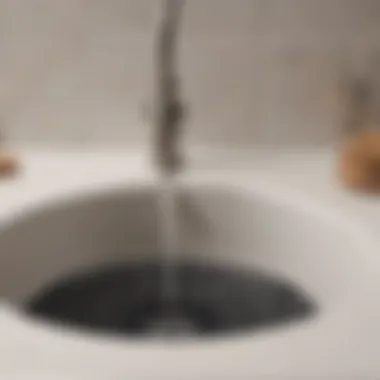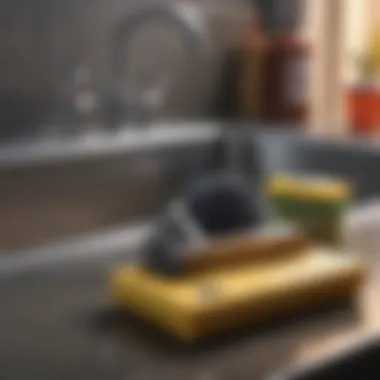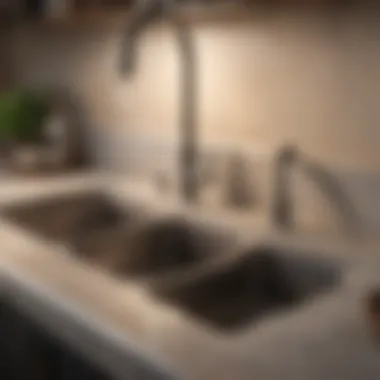Effective Methods for Cleaning Sink Drains


Intro
Cleaning sink drains is an essential task that often goes unnoticed until a significant problem arises. Many homeowners face clogged drains that lead to unpleasant odors and inefficient water flow. Understandably, this can be frustrating. It's vital to identify effective methods for maintaining clean drains, as it not only improves functionality but also enhances the overall hygiene of your kitchen or bathroom area. This article will delve into various techniques that range from traditional approaches to eco-friendly solutions. Each method will be explained comprehensively, providing you with insightful knowledge to tackle and prevent clogging issues.
Importance of Cleaning Sink Drains
Regular cleaning of sink drains holds several benefits. Clogged drains can lead to leakages and water damage, both of which may require costly repairs. More importantly, dirty drains can be a breeding ground for bacteria and unpleasant odors. Being proactive is key to maintaining healthy and functional plumbing. This article will cover:
- Why you should clean drains regularly
- Various tools and materials needed for efficient cleaning
- Step-by-step guides for effective cleaning
- Eco-friendly alternatives that do not harm the environment
By the end, you will have a robust understanding of how to keep your sink drains clear and odor-free.
Understanding Sink Drains
Understanding sink drains is essential for maintaining a functional and efficient household. Sink drains are often overlooked until a problem arises. Knowledge about these systems helps homeowners prevent issues before they start. People often assume that drains are simple and self-cleaning, but this is not the case.
Components of a Sink Drain System
A typical sink drain system includes several key components:
- Drain Pipe: This is where waste water flows when the sink is used.
- Trap: A U-shaped pipe that holds water. It prevents gases from entering your home.
- Drain Cover: Located at the sink's surface, it keeps larger debris from going down the drain.
- Vent: Essential for air circulation, it helps maintain drainage efficiency.
The Importance of Regular Maintenance
Regular maintenance of sink drains is critical for ensuring optimal performance and longevity. Homeowners often underestimate how continuously neglecting their drains can lead to serious, costly problems. Sink drains, by design, are susceptible to the accumulation of debris, soap scum, and other substances that can cause clogs. Therefore, understanding and committing to a maintenance schedule can significantly reduce the risks associated with such issues.
Benefits of Regular Maintenance
Engaging in routine maintenance brings several advantages:
- Prevents Clogs: Frequent checks and cleanings can catch potential blockages before they develop into significant clogs. Simple actions, like flushing with hot water, can be effective in maintaining clear paths.
- Improves Drainage Efficiency: Over time, even the most efficient plumbing can slow down if not properly maintained. Regular cleaning ensures that water flows freely, thus reducing instances of slow drainage that can lead to frustration.
- Cost-Effective: Investing time in regular maintenance can save homeowners substantial amounts on future plumbing repairs. Addressing minor issues early prevents them from escalating into major failures that require professional intervention.
- Extends Lifespan of Plumbing: Well-maintained plumbing systems tend to last longer. Continuous neglect can cause wear and tear on components, leading to premature breakdowns.
Considerations
When considering how to implement effective maintenance, there are a few elements to keep in mind:
- Frequency: Regular checks might be weekly, monthly, or bi-annually, depending on the kitchen or bathroom usage.
- Methods: Choose appropriate methods for cleaning, keeping in mind the potential surface damage certain chemicals may cause.
- Monitoring: Observe for unusual signs like foul odors or slow drainage. These can indicate underlying issues that need attention.
Routine maintenance transforms a daunting task into a manageable one, ultimately preventing distressing plumbing situations.
Identifying the Right Cleaning Products
Choosing the proper cleaning products for sink drains is essential in maintaining a hygienic and functional sink system. Different types of products serve various purposes and can either solve a problem or exacerbate it. When selecting cleaning products, it is vital to consider their effectiveness, safety, and environmental impact. A well-informed choice can result in cleaner drains without risking damage to your plumbing or harming the ecosystem.
Chemical Cleaners
Chemical cleaners are often the go-to solution for stubborn clogs and grime buildup. Products like Drano or Liquid-Plumr contain powerful ingredients designed to dissolve hair, grease, and other debris that block drains. These cleaners can provide quick results and are generally easy to use. However, while they can be effective, there are significant considerations:


- Corrosive Nature: Many chemical cleaners are harsh and can damage pipes if used frequently.
- Health Risks: The fumes can be harmful, leading to respiratory issues if inhaled.
- Environmental Concerns: Chemicals can harm aquatic life when they enter the water system.
Thus, while chemical cleaners can be beneficial in specific situations, care must be taken in their application and overall frequency of use.
Eco-Friendly Alternatives
For those who prioritize sustainability, eco-friendly cleaning solutions are an appealing choice. Brands like EcoSMART and Seventh Generation offer products that clean effectively while minimizing ecological footprints. Here are some advantages:
- Safer Ingredients: They use plant-based components, which are less harmful to family and pets.
- Less Environmental Impact: They reduce pollution risks associated with conventional cleaners.
- Good Results: Products designed for tough jobs can effectively tackle clogs without harmful chemicals.
Despite the benefits, it's important to note that eco-friendly solutions may require more time or multiple applications to achieve the desired results.
Homemade Cleaning Solutions
Homemade cleaning solutions are another prudent method for maintaining sink drains. Items commonly found in the pantry like baking soda and vinegar can be quite effective. The advantages of these solutions include:
- Cost-Effective: Ingredients like vinegar and baking soda are inexpensive compared to commercial cleaners.
- Non-Toxic: They pose no risk to health as they contain no harsh chemicals.
- Easy to Prepare: Simply combine one cup of baking soda with one cup of vinegar for a natural cleaning solution.
Using these homemade approaches is simple but may take persistence for serious clogs. If the blockage persists, further action might be required.
Step-by-Step Guide to Cleaning Sink Drains
Cleaning sink drains is an essential task that provides a fresh and functional kitchen or bathroom space. Following a systematic guide ensures that you do not miss any important steps and makes the overall process more efficient. Each phase focuses on different aspects, from preparation to the reassembly, establishing a comprehensive approach that reduces the risk of recurrent clogs or drainage problems.
Preparation
Gathering Tools and Materials
The first step in the cleaning process is to gather necessary tools and materials. This aspect is critical because having everything at hand streamlines the work and reduces frustration. Typical items include a plunger, a drain snake, cleaning solutions, and protective gloves. The importance of these tools cannot be overstated; having them readily available enables you to handle unexpected problems, like a stubborn clog, without delay.
A key characteristic of gathering these items is ensuring you select quality products. For example, a sturdy plunger is essential for applying the correct pressure, while a reliable drain snake can reach deeper clogs with ease. However, one must understand that not all products are created equally. Some drain snakes can damage pipes if used improperly. This is where the consideration of safety and effectiveness becomes crucial.
Safety Precautions
Safety precautions play a pivotal role in every cleaning endeavor. Wearing gloves protects your hands from harsh chemicals or sharp edges. This is particularly relevant when dealing with chemical cleaners, which may cause skin irritation. Additionally, if you are working under the sink, having a flashlight or a headlamp can prevent accidents and ensure a clear view of your actions.
The unique feature of safety precautions lies in their ability to prevent mishaps. Having a well-lit area and protective gear minimizes the risk of injury. While some may feel that these measures are unnecessary, the potential for accidents, especially involving chemicals or tools, makes them a beneficial choice for this article’s context.
Removing the Drain Cover
Once prepared, the next step is removing the drain cover. This initial action allows clear access to the drain itself. Using a screwdriver or appropriate tool, carefully unscrew the cover. Proper care is needed here, as overtightening in the past can make it difficult to unscrew later. Screws that are stripped may become problematic, requiring additional tools and effort to remove. This makes the task a bit challenging.


Clearing the Drain
Using a Plunger
Using a plunger is often the first method homeowners consider when faced with a stubborn clog. This method involves creating suction that can dislodge debris stuck in the pipes. A key characteristic is that plungers can be effective for various clogs, whether they are minor or moderately severe.
The unique feature of a plunger is its simplicity. Unlike chemical cleaners, it does not pose a risk to the environment or introduce harmful substances into your home. However, repeated unsuccessful attempts can be frustrating and may indicate a more serious blockage that requires advanced techniques.
Utilizing a Drain Snake
The use of a drain snake represents another practical approach to unclogging drains. This tool is designed to reach deeper within the plumbing system. By inserting the snake into the drain, you can snag and pull out clogs that may not be accessible with other methods.
A drain snake is valuable for its ability to navigate bends and curves in pipes. This makes it a popular choice for deeper clogs. However, caution is necessary as improper use can cause damage to pipes. Understanding your plumbing layout is essential when employing this method.
Applying Cleaning Solutions
Applying cleaning solutions can effectively break down grease, hair, and other debris. Commercial products may contain chemicals that dissolve clogs or deodorize the drain. Moreover, numerous eco-friendly alternatives promote safety for both the environment and your health.
The distinguishing aspect of using cleaning solutions is the range available. Choosing the right solution can enhance effectiveness when combined with physical methods like plungers and snakes. Some might argue that overuse of chemical cleaners could corrode pipes over time, hence moderation and careful selection are advised.
Reassembling the Drain
After efficiently clearing the drain, reassembly is the final step. Ensuring the drain cover is securely replaced helps prevent future issues, like dirt entering the system. Again, proper tightening is important; however, do not overtighten as this may make future maintenance difficult. Regular consideration of the drainage system's upkeep will ensure it remains functional for years to come.
Preventative Measures for Maintaining Clean Drains
Preventative measures are crucial for maintaining clean drains. By focusing on regular upkeep, homeowners can effectively reduce the likelihood of sudden clogs and other drainage issues. These practices not only enhance the lifespan of sink drains but also save the cost and hassle associated with emergency repairs.
Regular Inspections
Regular inspections of sink drains help identify potential problems before they escalate. Homeowners should take time periodically to check whether water is draining smoothly. If it is slow, this might indicate a developing clog. Look for unusual sounds, like gurgling, as they often signal that something is wrong.
Regularly inspecting your drain can prevent costly repairs and enhance the efficiency of your plumbing system.
Furthermore, check the p-trap, which is the curved pipe under the sink. It can trap debris over time. Cleaning this part can help sustain proper drainage. Keeping a schedule of inspections ensures that maintenance is not overlooked.
Using Drain Screens
Using drain screens or strainers is a simple yet effective method to filter out debris. They prevent larger items, such as food particles and hair, from entering the drain. Choosing high-quality screens designed for sinks can make this process easier.
- Easy Installation: Most drain screens fit easily over existing drain openings.
- Material Considerations: Stainless steel or silicone options are durable and easy to clean.
- Regular Cleaning: Ensure screens are cleaned frequently to maintain their effectiveness.


In the long run, investing a small amount in drain screens can save significant amounts in plumbing costs by preventing major clogs.
Disposing of Food Waste Properly
When it comes to maintaining clean drains, proper disposal of food waste is vital. Many homeowners believe that using the garbage disposal can handle any food scraps. However, this is a misconception. Some items can wreak havoc on the plumbing system.
Here's a list of items to avoid discarding in the sink:
- Grease and fat: These can solidify and cause blockages.
- Fibrous vegetables: Items like celery or artichokes can tangle and obstruct drain lines.
- Coffee grounds: While small, they build up over time leading to problematic clogs.
Educating household members about proper food disposal will contribute significantly to maintaining the integrity of sink drains.
Implementing these preventative measures fosters an environment where drains function optimally. By prioritizing regular check-ups, using physical barriers like screens, and disposing of waste responsibly, homeowners can protect their plumbing systems effectively.
When to Seek Professional Help
Knowing when to call for professional assistance is crucial for homeowners dealing with persistent sink drain issues. While many clogs can be effectively managed with DIY methods, certain situations necessitate expert intervention. This section will discuss the indicators that suggest the need for a plumber, providing clarity on the importance of professional evaluations. Consulting with specialists can save time, money, and minimize extensive damage.
Signs of Serious Clogs
A clear sign that professional help is needed is the presence of serious clogs. These are often characterized by:
- Recurring Blockages: If a drain repeatedly becomes clogged even after thorough cleaning, this may indicate a deeper issue.
- Slow Drainage: Obvious slow drainage in multiple sinks or bathtubs signals a more significant blockage that could be located further in the plumbing system.
- Water Backup: When water starts backing up into sinks, toilets, or other fixtures, it can indicate a severe clog in the main sewer line.
- Unpleasant Odors: Persistent foul smells emanating from drains may suggest decaying material or sewage issues that require immediate attention.
It is essential to pay attention to these signs, as they can escalate if not addressed soon. Waiting too long may lead to more damaging consequences to your plumbing system and home.
Identifying Underlying Plumbing Issues
Beyond just clogged drains, other plumbing issues can be contributing to the problems you face. The following factors may warrant professional assistance:
- Pipe Damage: Signs of corrosion or breaks in pipelines can lead to leaks and require repair. Such issues often go unnoticed until significant damage occurs.
- Persistent Overflow: If fixtures frequently overflow, it may suggest underlying plumbing system problems like roots intruding into pipes or buildup of debris elsewhere in the system.
- Low Water Pressure: This can sometimes point to clogs in pipes or other plumbing complications that need a professional plumber's evaluation.
- Sewage Issues: Any backing up of wastewater into your home raises alarms and presents health hazards. Quick professional intervention is vital in this scenario.
To summarize, seeking professional help when faced with serious clogs or underlying plumbing issues not only provides peace of mind but can also prevent potential disasters. The investment in professional assistance can prove invaluable in maintaining a functional and sanitary drainage system.
The End
Summary of Effective Practices
Several key practices have emerged as effective in maintaining clean sink drains, including:
- Regular Cleaning: Employing appropriate cleaning methods frequently prevents buildup that leads to clogs. Using solutions like baking soda and vinegar on a monthly basis can provide a natural cleaning alternative without harsh chemicals.
- Inspecting for Problems: Regular inspections, as discussed, can identify minor issues before they evolve into major repairs. Keeping an eye on drainage speed can be a good indicator of potential problems.
- Using Screens: Mesh or foam drain screens effectively trap debris and prevent food particles from entering the drain. This small addition can make a big difference in the maintenance of the system.
- Proper Disposal of Waste: Understanding how to dispose of kitchen waste correctly is crucial. Avoiding placing fibrous or starchy foods down the sink reduces the risk of clogs.
Implementing these methods will create a smoother experience using your sink.
Encouragement for Continued Maintenance
It is not enough to clean drains intermittently; continued maintenance is paramount. Encouraging a habit of regular checks and cleanings promotes a healthier plumbing system. Establishing reminders can help maintain consistency so that the cleaning becomes part of an ongoing routine rather than an occasional chore.
Furthermore, educating all household members about the importance of drain maintenance ensures that everyone plays a part in keeping the home running smoothly. Consider the long-term benefits; saving time and money on costly repairs can be achieved with just a little diligence.















